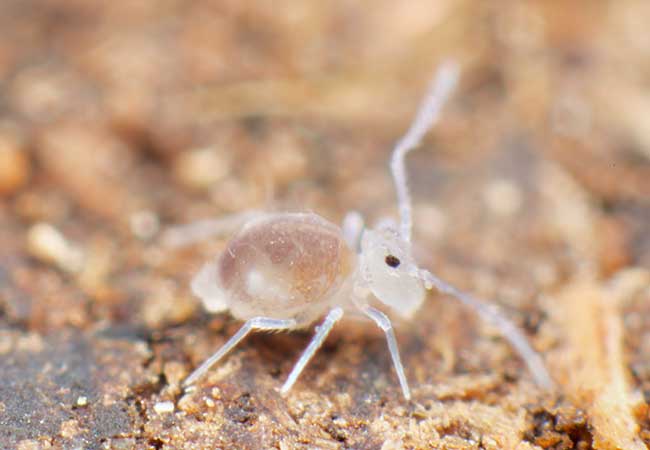When plants or parts of them die, billions of small creatures help to break down the organic material. Next to microorganisms such as bacteria and fungi, also some soil-living invertebrates seem to be involved in this process. A team of researchers from the LOEWE Centre for Translational Biodiversity Genomics (TBG) in Hesse, Germany, Goethe University Frankfurt and further institutions has now started to unravel the genetic basis of plant cell wall degradation in these invertebrates. Their findings will help to improve predictions of carbon and nutrient cycling in the soil.

picture: Andy Murray, chaosofdelight.org
They live in large numbers in the soil and are represented by a wide variety of species: microscopically small invertebrate soil animals such as springtails and horn mites. They break down organic matter and release nutrients for plants. In a study published in the journal “Molecular Ecology”, researchers have now discovered that a much larger proportion of their species may also be directly involved in decomposing dead plant material. Until now, this ability has been attributed mainly to bacteria and fungi. To break down cellulose, the main component of plant cell walls, the organisms must be able to produce certain enzymes.
In detailed genome analyses of different species of springtails (Collembola) and horn mites (Oribatida), the researchers revealed that a particular gene encoding one of these special enzymes is present in most of the investigated species. It belongs to a class of enzymes called glycoside hydrolases, which break down complex sugar molecules into simpler components. Cellulose is such a polysaccharide. For their study, the scientists analysed 232 species of soil invertebrates. The “Metagenomic monitoring of soil communities (MetaInvert)” project, which is based at the LOEWE Centre TBG and provides genomic data on these under-researched organisms, offered a comprehensive resource.
“New genomic analysis methods are helping us to gain important insights into this species-rich group of animals, which is difficult to study due to its small size and enormous diversity,” reports co-study leader Ingo Ebersberger, Professor of Applied Bioinformatics at the Faculty of Biosciences at Goethe University Frankfurt and member of the LOEWE Centre TBG. “With the help of bioinformatic analyses, we were able to test all samples for the presence of the gene that enables the animals to break down cellulose.” New software developed by Ebersberger’s PhD student and first author of the study, Hannah Mülbaier, contributed significantly to the success of the study and made it possible to search for specific genes in genomes in a targeted and very precise way. “What is new about this software is that it eliminates a very complex, time-consuming and labour-intensive step: predicting all the genes in a genome. Instead, we can now search for our candidate genes directly in a genome sequence,” says Ebersberger.
Based on the new findings and their implications for understanding food webs and the carbon cycle in soil, the authors of the study argue that soil invertebrates should be considered as a third evolutionary and ecologically independent group with the ability to degrade cellulose, alongside bacteria and fungi. This is particularly important because these animals respond differently to environmental changes than microorganisms, and decomposition processes could change as a result. The data is also important for calculating models that make predictions about the development of ecosystems and carbon and nutrient cycles.
Publication: Hannah Muelbaier, Freya Arthen, Gemma Collins, Thomas Hickler, Karin Hohberg, Ricarda Lehmitz, Yannick Pauchet, Markus Pfenninger, Anton Potapov, Juliane Romahn, Ina Schaefer, Stefan Scheu, Clément Schneider, Ingo Ebersberger, Miklós Bálint. Genomic evidence for the widespread presence of GH45 cellulases among soil invertebrates. Molecular Ecology (2024) https://doi.org/10.1111/mec.17351








